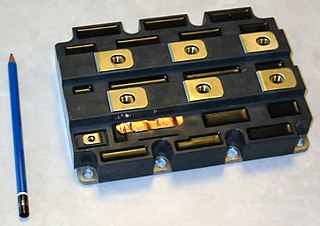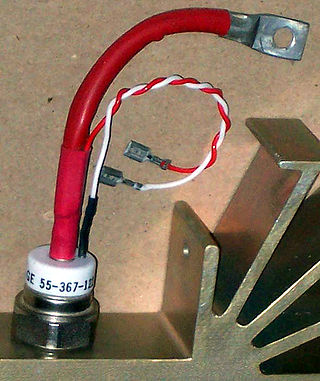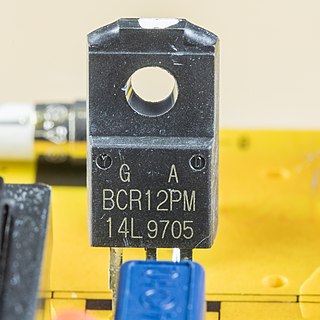Related Research Articles

A diode is a two-terminal electronic component that conducts current primarily in one direction. It has low resistance in one direction and high resistance in the other.

A transistor is a semiconductor device used to amplify or switch electrical signals and power. It is one of the basic building blocks of modern electronics. It is composed of semiconductor material, usually with at least three terminals for connection to an electronic circuit. A voltage or current applied to one pair of the transistor's terminals controls the current through another pair of terminals. Because the controlled (output) power can be higher than the controlling (input) power, a transistor can amplify a signal. Some transistors are packaged individually, but many more in miniature form are found embedded in integrated circuits. Because transistors are the key active components in practically all modern electronics, many people consider them one of the 20th century's greatest inventions.
A semiconductor device is an electronic component that relies on the electronic properties of a semiconductor material for its function. Its conductivity lies between conductors and insulators. Semiconductor devices have replaced vacuum tubes in most applications. They conduct electric current in the solid state, rather than as free electrons across a vacuum or as free electrons and ions through an ionized gas.

A bipolar junction transistor (BJT) is a type of transistor that uses both electrons and electron holes as charge carriers. In contrast, a unipolar transistor, such as a field-effect transistor (FET), uses only one kind of charge carrier. A bipolar transistor allows a small current injected at one of its terminals to control a much larger current flowing between the terminals, making the device capable of amplification or switching.

An insulated-gate bipolar transistor (IGBT) is a three-terminal power semiconductor device primarily forming an electronic switch. It was developed to combine high efficiency with fast switching. It consists of four alternating layers (P–N–P–N) that are controlled by a metal–oxide–semiconductor (MOS) gate structure.

A thyristor is a solid-state semiconductor device with four layers of alternating P- and N-type materials used for high-power applications. It acts as a bistable switch. There are two designs, differing in what triggers the conducting state. In a three-lead thyristor, a small current on its gate lead controls the larger current of the anode-to-cathode path. In a two-lead thyristor, conduction begins when the potential difference between the anode and cathode themselves is sufficiently large. The thyristor continues conducting until the voltage across the device is reverse-biased or the voltage is removed, or through the control gate signal on newer types.

The Schottky diode, also known as Schottky barrier diode or hot-carrier diode, is a semiconductor diode formed by the junction of a semiconductor with a metal. It has a low forward voltage drop and a very fast switching action. The cat's-whisker detectors used in the early days of wireless and metal rectifiers used in early power applications can be considered primitive Schottky diodes.

A silicon controlled rectifier or semiconductor controlled rectifier is a four-layer solid-state current-controlling device. The name "silicon controlled rectifier" is General Electric's trade name for a type of thyristor. The principle of four-layer p–n–p–n switching was developed by Moll, Tanenbaum, Goldey, and Holonyak of Bell Laboratories in 1956. The practical demonstration of silicon controlled switching and detailed theoretical behavior of a device in agreement with the experimental results was presented by Dr Ian M. Mackintosh of Bell Laboratories in January 1958. The SCR was developed by a team of power engineers led by Gordon Hall and commercialized by Frank W. "Bill" Gutzwiller in 1957.

A TRIAC is a three-terminal electronic component that conducts current in either direction when triggered. The term TRIAC is a genericised trademark.

The integrated gate-commutated thyristor (IGCT) is a power semiconductor electronic device, used for switching electric current in industrial equipment. It is related to the gate turn-off (GTO) thyristor.
A power semiconductor device is a semiconductor device used as a switch or rectifier in power electronics. Such a device is also called a power device or, when used in an integrated circuit, a power IC.

Power electronics is the application of electronics to the control and conversion of electric power.
In computer engineering, a logic family is one of two related concepts:
A snubber is a device used to suppress a phenomenon such as voltage transients in electrical systems, pressure transients in fluid systems or excess force or rapid movement in mechanical systems.

An electronic component is any basic discrete electronic device or physical entity part of an electronic system used to affect electrons or their associated fields. Electronic components are mostly industrial products, available in a singular form and are not to be confused with electrical elements, which are conceptual abstractions representing idealized electronic components and elements. A datasheet for an electronic component is a technical document that provides detailed information about the component's specifications, characteristics, and performance.

A power MOSFET is a specific type of metal–oxide–semiconductor field-effect transistor (MOSFET) designed to handle significant power levels. Compared to the other power semiconductor devices, such as an insulated-gate bipolar transistor (IGBT) or a thyristor, its main advantages are high switching speed and good efficiency at low voltages. It shares with the IGBT an isolated gate that makes it easy to drive. They can be subject to low gain, sometimes to a degree that the gate voltage needs to be higher than the voltage under control.

A gate turn-off thyristor (GTO) is a special type of thyristor, which is a high-power semiconductor device. It was invented by General Electric. GTOs, as opposed to normal thyristors, are fully controllable switches which can be turned on and off by their gate lead.
In electronics, an electronic switch is a switch controlled by an active electronic component or device. Without using moving parts, they are called solid state switches, which distinguishes them from mechanical switches.
The following outline is provided as an overview of and topical guide to electronics:

The field-effect transistor (FET) is a type of transistor that uses an electric field to control the flow of current in a semiconductor. It comes in two types: junction FET (JFET) and metal-oxide-semiconductor FET (MOSFET). FETs have three terminals: source, gate, and drain. FETs control the flow of current by the application of a voltage to the gate, which in turn alters the conductivity between the drain and source.
References
- Notes
- S. Eio., N. Shammas., “IGBT Tail Current Reduction by Current Injection,” 43rd International Universities Power Engineering Conference, Padova, Italy,1 – 4 September 2008
- S. Eio., N. Shammas., “A chopper circuit with current injection technique for increasing operating frequency,” 9th International Seminar On Power Semiconductors, Prague, Czech Republic, 27–29 August 2008
- S. Eio., N. Shammas., “Switching Transient of Power Diode,” 41st International Universities Power Engineering Conference, Newcastle, United Kingdom, 6–8 September 2006, Volume 2, P. 564 – 568, Digital Object Identifier 10.1109 / UPEC.2006.367541
- N. Shammas., S. Eio., “A Novel Technique to Reduce the Reverse Recovery Charge of a Power Diode,” 12th European Power Electronics and Applications, EPE 2007, Aalborg, Denmark, 2–5 September. 2007 P.1 – 8, Digital Object Identifier 10.1109 / EPE.2007.4417713
- N. Shammas., S. Eio., “A Novel Technique to Reduce the Reverse Recovery Charge of a Power Thyristor,” 42nd International Universities Power Engineering Conference, Brighton, United Kingdom, 4 – 6 September 2007, p. 1222–1227, Digital Object Identifier 10.1109 / UPEC.2007.4469126
- N. Shammas., S. Eio., D. Chamund., “Semiconductor Devices and Their Use in Power Electronic Applications,” World Scientific and Eng. Academy and Society, Venice, Italy, 21 -23 Nov 2007
- N.Shammas, S.Eio, S.Nathan, K.Shukry, D.Chamund., “Thermal Aspects of Power Semiconductor Devices and Systems,” VII Conference Thermal Problems in Electronics, MicroTherm’07, 24 – 28 June 2007, Lodz, Poland